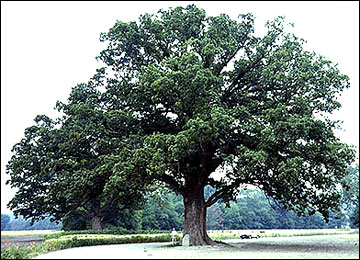Trees are the basic element for any landscape plan. They set the stage for the entire home grounds design. The type used and their location determine to a great extent what other plantings are appropriate.
Trees are the most permanent plants we grow. Many will live and enhance the landscape for 100 or more years if they are given a chance. Because of the permanency of trees and their importance in the landscape, care must be taken to select the best species for each situation (Figure 1). The wrong tree or one planted in the wrong spot can actually detract from the overall landscape. Five to 10 years of precious tree growing time may be lost before the mistake is realized.
 Figure 1
Figure 1
Like the bur oak, many of Missouri's native oak species develop into large, strong-branched shade trees.
How to choose trees
No species or variety of tree is sufficiently superior to be called "best" without some qualifications. However, there are many excellent varieties. Choosing a variety with the characteristics that will provide the greatest satisfaction in a given situation requires careful consideration.
Most homeowners make the mistake of deciding what kind of tree they want and then trying to fit it into their landscape. A more positive approach is to decide where a tree is needed and what that tree should do in the landscape. After the desired type of tree has been determined, then it is much easier to select a species to fulfill these requirements.
Avoid trees that are susceptible to storm damage, ones that are hosts to destructive insect and disease pests and those that produce an over abundance of objectionable seed or fruit. The choice will generally depend on existing conditions at the planting site. These include room for top and root growth, soil type, subsurface drainage and kind of plants you want to grow under the tree.
A tree is a long-term investment. Therefore, start with a high-quality plant. Trees 8 to 10 feet tall, either balled and burlapped or growing in containers, are usually the best buy. Species that are difficult to transplant may be more easily established if you start with smaller sizes. A reputable dealer will usually help select the tree and will guarantee it to be alive and healthy.
If you don't have a green thumb, the nursery will probably plant the tree for a small additional cost.
Tree species described in this publication are the ones most commonly available in retail nurseries and garden centers Some species have been included on the list because they are commonly available even though they are not recommended for general landscape planting.
The table shows the maximum height to which each species can be expected to grow. It also rates the relative merits of each species for eight different factors that should be considered when making a selection.
Your local nursery will probably not have all of the species included in this list in stock. However, you can usually order a specimen if you allow enough time.
Improved varieties are available for most of the species in this list. In most cases, these varieties need to be asexually propagated from the original selected parent. Most of the selected varieties are superior to the standard varieties grown from seed and well worth the added cost needed to produce them.
The trees listed in the following section have been divided into three groups according their size. The large trees reach a mature height of greater than 60 feet. Trees with a mature height between 30 and 60 feet make up the medium-sized group. Relatively few shade trees are less than 30 feet tall. The need for small trees may often be satisfied by flowering trees.